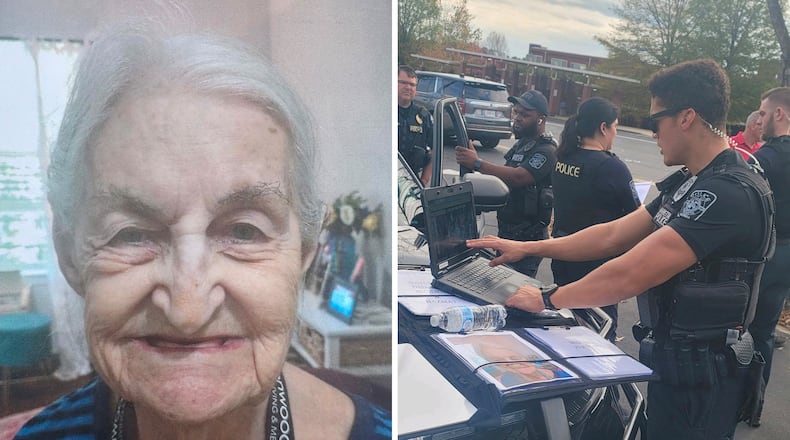No one had checked on an elderly woman the night she went missing from a persistently understaffed Marietta senior care home. Then, once her disappearance was discovered the next morning, staff waited nearly two hours before notifying police.
Those are among nine violations found by the Georgia Department of Community Health when it investigated Greenwood Place after the woman, 89-year-old Patricia Miele, was found dead.
At the time, Diana Ferrante Thies, a senior vice president at Greenwood, said that door systems and alarms were working properly and that community protocols were followed upon staff learning that Miele was gone.
But the inspection report raises questions about the facility’s actual adherence to community protocols — as well as the state’s approach to holding care homes accountable when they violate state requirements.
Miele and the assisted living facility made news during a chilly weekend last fall when local police were alerted and sought the community’s help in finding the missing resident. An all-hands-on-deck search ensued from the afternoon of Saturday, Nov. 9, to the afternoon of Monday, Nov. 11. The 48-hour search ended when Miele’s body was discovered in a pond about half a mile from the residence. A coroner later ruled Miele died of an accidental drowning.
DCH completed its inspection Dec. 10 and recently uploaded it to the regulatory body’s public database.
Credit: HYOSUB SHIN / AJC
Credit: HYOSUB SHIN / AJC
The most serious violations, according to the report, dealt with staffing levels and a failure to appropriately contact law enforcement once the resident was discovered missing.
While assisted living facilities are supposed to have one caregiver on each floor during a shift, there was only one person manning the home’s two floors during the 11 p.m. to 7 a.m. shift the night Miele went missing. This left 26 residents unsupervised when the caregiver was on a different floor, the report says. And while Miele was not in a memory care unit, the report also notes that this wing of the facility failed to have the required certified medication aide or nurse.
The home also had been flagged in April for understaffing. But the state gave Greenwood Place the lowest violation grade — a D — which came with zero financial penalty. The facility just had to create a plan of correction.
That plan was not followed, the December report found. Months later, the home still failed to have enough caregivers. A review of time sheets showed the facility was “consistently understaffed” from Nov. 1-Nov. 16, the report says.
The report ties the understaffing to Miele’s disappearance, noting that an interview with the lone caregiver during the night shift established that they did not check on her.
“During an interview Staff F stated that he/she did not check on (make rounds on) Resident #1 (who was diagnosed with a cognitive impairment) at the beginning, during the middle of, or the end of his/her eight hour 11:00 p.m. - 7:00 a.m. shift,” the report says.
While it is unclear when or how Miele got out of the facility, the report also notes that surveillance footage obtained by the police showed that Miele was seen wandering outside the Greenwood Place property at 2 a.m.
The second major issue according to the report was communication with police. Staff discovered Miele was missing at 7:10 a.m. While state law requires law enforcement to be contacted within 30 minutes when a resident goes missing, the report noted that law enforcement was not contacted till after 9:30 a.m.
The report also noted infractions not necessarily tied to the incident, such as the fact that five of nine surveyed staff did not have satisfactory criminal record checks and were not trained in first aid or CPR.
Greenwood Place did not respond to a request for comment.
Miele’s family members could not be reached for comment.
Credit: HYOSUB SHIN / AJC
Credit: HYOSUB SHIN / AJC
While the report answers some questions about the night Miele went missing, it does not reveal how the state plans to hold the facility accountable.
When inspecting facilities, the state utilizes a matrix to assess the severity of violations and therefore fines. According to the report, Greenwood had five D-level violations — which are the lowest possible and come with zero fines; two E violations — which are the next lowest and typically come with $300 fines; and two Ks — which are the second highest and typically come with $1,600 fines.
Based on those letter grades, the total estimated penalty would be $3,800. That is significantly lower than the $5,000 senior care homes are supposed to be fined for infractions that cause a resident to be seriously harmed or to die.
DCH declined to tell The Atlanta Journal-Constitution how much it fined Greenwood Place, saying the information would only be released with a public records request.
The state has yet to respond to the AJC’s subsequent formal request.
The mandatory $5,000 fine was part of 2020 state legislation aimed at bolstering transparency and protections for the elderly within the ever-growing assisted living and personal care home sector. State lawmakers passed the reforms following an AJC investigation that documented abuse and neglect across the private-pay senior care industry. As part of the new law, which took effect in July 2021, the state increased home staffing requirements as well as fines.
But a fall 2024 two-part investigation by the AJC found the state was falling woefully short when it came to implementing these new measures.
The AJC found that over a recent 12-month period, more than 90% of violations at assisted living and large personal care homes were given D rankings — curiously doled out even despite dangerous and repeated infractions.
In the rare scenario where higher-level ratings were given, the AJC found that if facilities contested, the state was usually willing to enter into a settlement agreement. These could cushion fines by not only giving facilities more time to pay, but also by significantly reducing the actual penalty.
The AJC’s 2024 investigation also found that dozens of people had gone missing from Georgia assisted living and personal care homes between January 2023 and July 2024, but that even in cases where the residents died, the state did not stick to the mandate of fining care homes $5,000.
In a November 2023 case, where a resident was struck by a car and died after wandering away from a personal care home, the state initially imposed a $6,003 fine after citing five violations. But after the facility contested the fine, the state reduced the penalty to $3,000 to be paid over the course of a year in $250 increments.
In another incident from last February, a resident’s frozen remains were discovered by a ravine 10 days after he wandered off from a personal care home 3 miles away. The facility was fined $1,201 despite the subsequent inspection report showing that the resident had been gone 11 hours before staff at the facility noticed; chimes on the exit doors weren’t working; and the home didn’t have an awake caregiver at night.
DCH wouldn’t explain the diminished fines in either case.
The lack of follow-through with fines — as well as the under-coding of violations — is an issue that many advocates are concerned about, according to Melanie McNeil, Georgia’s long-term care ombudsman.
“If the fines aren’t significant, it just becomes the cost of doing business,” McNeil told the AJC last fall. “You just build that into your budget.”
About the Author
Keep Reading
The Latest
Featured





